Uighur Cuisine, Haymarket
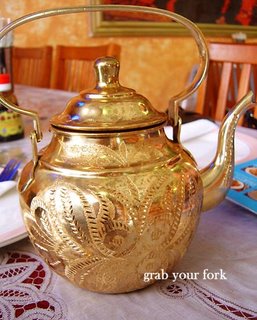
I recently received a friendly email from Jenny, a GrabYourFork reader who, along with other recommendations, encouraged me to try Uighur food, available at a number of dedicated restaurants in Sydney's Chinatown. I had never heard of such a cuisine, and the fact that the Uighur people (also spelled as Uyghur and Uygur) lived in China, motherland of my ancestral heritage (although shamefully I have the linguistic capability of a tempestuous two-year-old), made me insatiably curious to check it out as soon as possible.
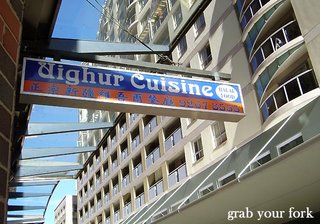
With fellow foodblogger Rebecca for photo-snapping company, we headed to Uighur Cuisine, located at the often-forgotten end of Dixon Street, crossing the lights at Goulburn Street and walking down the pedestrian mall past the old Chinese cinemas and the brand spanking new apartment complex.
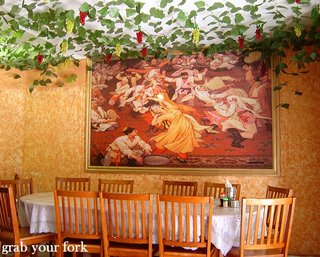
The decor is remarkably familiar. Giant tapestries (or prints of them) on the walls, musical instruments mounted on vibrantly woven tapestry-backed frames, and a ceiling shrouded by a complex network of vine leaves and hanging grapes--plastic but spectacularly striking nonetheless.
I am no stranger to vine-leaved ceilings. They adorn many a noodle house in Chinatown, although me, in my oblivious cultural narrow-mindedness, had always dismissed them as some kind of bizarre form of cheap misguided Italian-themed decoration. When we ask our friendly waiter at Uighur Cusine the reason for the vines, he smiles, closes his eyes briefly, and speaks wistfully of the grape vines that grow in abundance where he comes from, how they line the streets with shade and cool shelter, and how his people love to sit underneath them, sharing in good meals and long conversations.
I feel so stupid. And I adore the vine leaves now because of this evocative description.
The menu is a pictorial A3 laminate, double-sided in blue and broken up into categories. There are so many options that we take about ten minutes to decide.
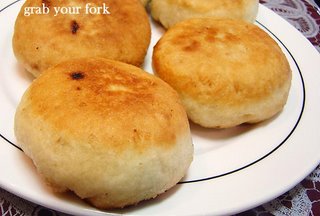
Hoshang $8.00
Braised and steamed Uighur dumpling (5 per serve)
We start with Hoshang dumplings which, from the menu photo, look like steamed pan-fried dumplings. They are quite heavy buns though, a stodgy theme that runs throughout much of their cuisine as we soon discover.
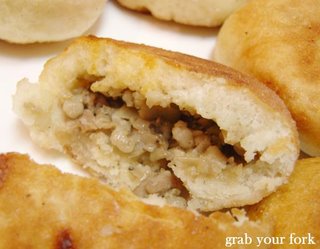
Inside the Hoshang dumpling
The buns are filled with a mixture of lamb mince and onion. The meat is unspiced and rather plain-tasting, although the unmistakable taste of lamb fat makes its presence known with its sticky texture and lingering mouthfeel.
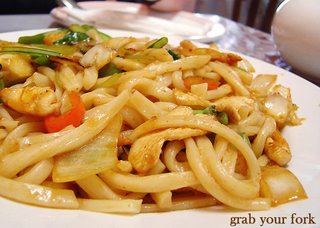
Laghman Saomian $7.50
Uighur hand-made noodles stir-fried with vegetables and chicken
The Langhman Saomian is a fairly familiar dish of chewy handmade noodles stir-fried with onion, chicken and vegetables. Laghman or langman, I discover via Google, is apparently one of the most popular dishes in Uighur cuisine, often known as "a dish of love". Every dish in Uighur cuisine has symbolic meaning and acccording to tradition, love should last as long as the length of the noodles. Awwwwwww..........
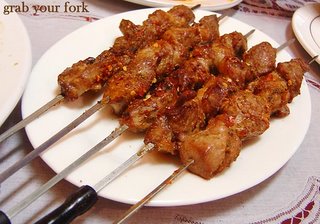
Koy Gosh Kawapi $10.00
Lamb kebab (5 skewers)
Lamb plays an obvious major role in the diet of the Uighur people. Their reverence for lamb could not be more apparent than the menu's giant photo offer of Putun Koy Tonor Kawapi or a whole lamb kebab for $350.00, a hefty affair which unsurpisingly requires one week's notice. If that seems too generous one could elect the Pachak Kawipi lamb leg kebab for $75.00. Only one day's notice for that one.
For two people though, we opt for the Koy Gosh Kawapi which arrives as a generous serving of five lamb kebabs on flattened metal skewers.
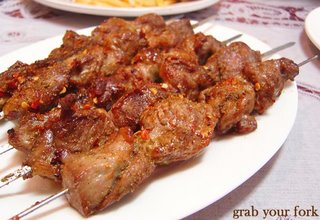
These are meaty affairs encrusted with a spicy rub of chilli flakes, salt, black pepper and a uniquely Uighur herb known as zir. They have a pleasing chewy meatiness to them; they are not tough, but they are substantial, and the chilli flakes give some much welcomed life to my delighted tastebuds.
There are so many interesting-looking items on the menu, but there is only so much two foodbloggers can eat. So a few weeks later, with waistbands back to their pre-starchfest size, we head there again for a follow-up visit (we're becoming, like, professional food critics, no?).
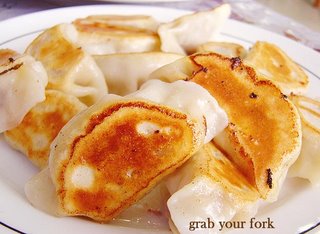
Tawa Ban Shir $7.80
Fried dumplings
This time we try the Tawa Ban Shir or fried dumplings. These are distant cousins of Chinese dumplings or Japanese gyoza, although with the majority of Uighurs practising Muslims, pork is definitely an unwelcome stranger.
The dumpling are filled with a dense pocket of finely minced lamb, onion and some spring onions too. The medium-thickness skins are quite smooth, fried to a crisp on one side which contrasts nicely with the faint hint of soup within.

Manpar Saomian $7.80
Square-cut Uighur pasta with stir-fried vegetables and beef
I had been fascinated by the idea of square-cut pasta when perusing the menu on our last visit, so we order the Manpar Saomian this time. I had anticipated quite a thin supple noodle, slippery and silky like Chinese rice noodle sheets, but I am happy to discover that these are thick chewy wads of noodle, akin to, but not quite as filling as Chinese New Year cake. It is addictively more-ish for this lover of starch.
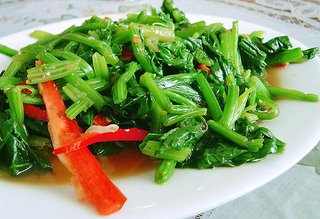
Palak Hum Sai $4.50
Spicy spinach salad
Remembering the distinct lack of vegetables from our last visit, we order a side of vegetables. There are a couple of options that catch the eye, including Alma Salat apple salad with sweeteners for $3.50; and Kawa Sama pumpkin samosa for $7.00. The Yaghda Pishirilgan Yangyo stir fried potato for $5.00 looks remarkably similar to a plate of French fries, but in the end we go for a simple spicy spinach salad or Palak Hum Sai.
The Chinese water spinach is a happy health-giving green and garnished with bright slivers of crunchy red capsicum. There's a distinct vinegary taste to this dish, which refreshes the palate and helps flush out the aftertaste of grease. We dip into this dish with much relief throughout our meal, particularly with respect to our final dish which arrives with a flourish.
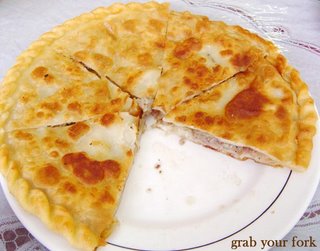
Gosh Nun $10.00
Meat in special Uighur pastry
The Gosh Nun is a giant disc of meat-filled pie cooked in a cauldron. We ooh over the pretty golden crust, and the delicate pleats folded in along the edges.

Inside the Gosh Nun meat in special Uighur pastry
The pleats are a little dry and chewy though and the meat is unbelievably mutton-like for my palate. It's too fatty and tongue-congealing for my taste, but Rebecca thinks it's fine, although she's grateful for the vinegary spinach too.
There are a couple of other dishes which appeal to my adventurous tastebuds, things like Koy Till Salat lamb tongue in special sauce for $7.80; Burak Kormisi specially prepared kidney for $10.00; and Upkda Kormisi stir-fried lung for $15.00. Stuffed lungs, or lights, is apparently an Uighur delicacy. Butchers take care not to puncture the lungs, which are tested by inflating them, then they are filled with a stuffing of dough, milk, eggs and oil, tied up and cooked immersed in boiling water.
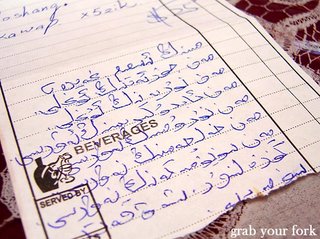
Our bill in Uighur
A Roman script was originally used in China with a new Arabic script
introduced in 1987. Cyrillic script has been used throughout.
The food is plain and yes there's plenty of lamb and lamb fat, but we make use of the DIY chilli sauce and down endless cups of tea. Staffed by close-knit family members, service was patient and extremely hospitable. They are a beautiful people too, with luminiscent pale skin, dark brown hair and thoughtful soul-searching eyes.
Other random facts I've learnt about the Uighur people this weekend on Google:
- The Uighur are a Turkic people and one of 56 ethnic groups officially recognised by the People's Republic of China
- There are over 7 million Uighurs in China (1990 census) with 4.7 million living in Xinjiang (sometimes known as East Turkestan), China's most remote province through which the Silk Road passes
- Uighur communities can be found in Kazakhstan (300,000), Afghanistan (3,000), Kirgizistan and Uzbekistan. There is also a large Uighur community in Turkey.
- Tea is an important tradition which is served in a myriad of ways with accompanying rituals. The Uighurs from the Seven River region make atkan cay tea with salt and milk. At breakfast it is served in big bowls with the addition of cream, sour cream and butter, turning it into a filling meal known as apqur cina.
- The Uighur have more than 40 different methods of making bread
- People live longer in the Uighur region than anywhere else in China. Of all the people who are over 100 years old in China, 25% of them come from Xinjiang.

Uighur Cuisine
Shop 1, 2 Dixon St, Haymarket, Sydney
(corner of Liverpool Street and Dixon Streets)
Tel: +61 (02) 9267 8555
posted by Anonymous on 7/16/2006 11:58:00 pm





21 Comments:
At 7/17/2006 7:41 am, Reb said…
Reb said…
Not sure about the lamb fat, but everything else must be good for you! Great description ... I think our lunches lasted as long as the length of the noodles :)
At 7/17/2006 8:26 am, flexnib said…
flexnib said…
Wow - thanks for sharing this, an interesting cuisine! I wonder if there are any Uigur restaurants in Perth..
At 7/17/2006 8:48 am, Robyn said…
Robyn said…
Ohhh man, I love Uighur food (and I'm saying that after only having eaten it once). Beautiful photos! Looove those handmade noodles. I didn't know Uighur people lived so long. :D
At 7/17/2006 11:29 am, Veruca Salt said…
Veruca Salt said…
Looks interesting. You know I love grase as much as the next gal but am scared of lamb fat congealing on my tongue.
At 7/17/2006 1:11 pm, Bex said…
Bex said…
That was a great review! I've always wanted to try Uyghur cuisine - i thought it might be abit lamb-y! I might go try it out.
PS. When I was a kid and did chinese folk dancing (my parents were big on cultural heritage) we learnt a dance called the 'picking grapes' which was from that region! I once saw a performance by professional dancers from that region - they were the most beautiful mix of asian and middle eastern features.
At 7/17/2006 2:04 pm, ragingyoghurt said…
ragingyoghurt said…
starchfest!! those buns and dumplings look so yummy... more specifically, the golden panfried crust on the buns and dumpings look so yummy. (were they fried in lamb fat? :) )
At 7/18/2006 3:05 pm, thekillereater said…
thekillereater said…
thought id let you know ive been visiting your site for several month now and it never leaves me not hungry! I love it!
keep up with the great work, love the photos and you always seems to be politically correct with your food too!
At 7/26/2006 4:26 am, Anonymous said…
Anonymous said…
It is interesting that so many chinese words show up in Uighur language. "Langman" would be "La Mian" (hand pulled noodles) in Mandarin. And "Yangyo" would be "Yang Yu" (Foreign Yam). It is a shame the Uighurs and ethnic Chinese are so hostile toward each other in Xinjiang.
At 7/30/2006 1:35 pm, Anonymous said…
Anonymous said…
This brings back memories of my trip to Xinjiang last year. Lamb everything, and heaps of carby, oily noodles and buns. Now I will definitely have to try out the Uyghur restaurant.
Laura (sydfoodblog)
At 8/02/2006 1:11 am, Anonymous said…
Anonymous said…
this place does a great chicken dish.....not sure what it's called, but it comes in a big plate and has stacks of chicken, potato, onions, hand made thick cut noodles and chilli in it. the sauce in this dish is simply divine, a symphony of chilli and exotic spices (and possibly some other ingredients too, although i have no idea what it is) that just kicks the appetite up one gear.
and i've love to try their whole lamb roast one day :-)
At 8/11/2006 1:06 am, Anonymous said…
Anonymous said…
Hi, I tried the chicken dish there too - it was amazing! It has whole pieces of garlic and little chillies, potatoes, a spiced curry-ish soup that is an amazing blend of middle eastern and asian. I loved that restaurant! Where are some of the other Uighur restaurants in Haymarkte?
- Bron
At 12/18/2006 2:52 am, Anonymous said…
Anonymous said…
I love Xinjiang food too! Xinjiang being the place where Uigur people live in China. When I used to live in BJ, we'd have 'yang rou chuar' (Uigur lamb kebabs) off the streets for RMB2! There's always a mix of meat and fat in each skewer to keep the meat succulent and flavourful.
Hope you get the chance to try the real stuff in Beijing (many great Xinjian restaurants) or Xinjiang!
At 6/07/2007 8:10 pm, Anonymous said…
Anonymous said…
I'm finally delurking. You are my guide to Asian food in Sydney - I am a regular visitor from Melbourne.
I have had Uighur food in Guangzhou and Shanghai. This place is great - the fatty lamb skewers are to die for, and my wife and I often don't get past the lamb kebabs and nan bread.
Every Xinjiang restraurant in China has dancing - this place just has the video. I think the grapevine is part of the franchise agreement.
At 6/07/2007 9:41 pm, Helen (Grab Your Fork) said…
Helen (Grab Your Fork) said…
Hi mr_gimlet - Thanks for delurking :) Now there's no excuse for more comments. lol
I'm glad you've found GrabYourFork useful. I'd love to try Uighur food in China. And dancers? Wow. That would be perfect!
At 7/05/2007 9:41 am, Anonymous said…
Anonymous said…
It's easy to say "Why can't we all get along?" if you have no part in the conflict. If you were an ethnic Turkish Uighur living in what once was a 95 percent ethnic Turkish Muslim region of Central Asia and beginning in 1949 Mao started a policy of forced migration of millions of Han people into Xinjiang to shift the political balance, you might feel there is a cause at stake. And if your kids had no English teachers ever while children in Han schools had English teachers from grade 7 onward, well, you get the picture.
But I do love Uighur food and have enjoyed it for 4 years now in China. Fat is a big part of the Asian diet but no one forces you to eat it. Checheran (not sure about the spelling) is another popular Uighur dish, a soup of tortellini stuffed with mutton.
At 7/06/2007 12:29 am, Helen (Grab Your Fork) said…
Helen (Grab Your Fork) said…
Hi Anon - I have strong empathetic feelings towards the Turkish Uighurs, which is primarily why I felt it important to highlight some of the Google facts I uncovered. The sentence you quote was actually said with inverse intentions to the one you interpreted :)
Fat is an everyday part of the Asian diet, but then plenty of exercise and physical labour is too! Many of us, okay I, am all too slovenly for my own good!
And thanks for the tip on Checheran. I'll have to keep an eye on that one for next time.
At 12/07/2007 3:12 pm, Anonymous said…
Anonymous said…
This is a very yummy restaurant and the food has a nice taste. The lamb fat is no problem with the vinegar salad clean the mouth.
Does anyone know where you can get some zir in Sydney and\or provide some information about it.
At 12/24/2007 7:59 pm, Helen (Grab Your Fork) said…
Helen (Grab Your Fork) said…
Hi Lachlan - A little bit of vinegar definitely goes a long way in cleansing the palate of oil. I'm not sure about zir but hopefully a reader may be able to help.
At 10/11/2009 3:39 am, Rae said…
Rae said…
I know i'm revisiting a very old thread. This post brings me back to China (I was born in Xinjiang, my father is Han Chinese and my mother Uighur) and i have been afraid to try Sydney Uighur food for fear of mass disappointment.
Zir (Uighur) or Ziran (Mandarin) is simply cumin with salt.
Lagman (Uighur) or La Mian (Mandarin) literally means 'pulled noodles' and if you have ever watched someone make these in person it is impressive. They can pull a single noodle strand until it is 5m long and weighing down their arm.
This post has inspired me and tomorrow i will venture to Haymarket to try Sydney Uighur food, i always assumed it would be mainland Chinese people making it and thought the authenticity would be lacking. Thanks!!!
P.S. another interesting fact about Xinjiang is that it is the point on the earth farthest from a large body of water - you get off the plane and can feel the dryness like a lump in your throat.
At 10/13/2009 2:08 pm, Helen (Grab Your Fork) said…
Helen (Grab Your Fork) said…
Hi Rae - Thank you so much for all your extra details. I'm always amazed by pulled noodles - they make it look so effortless.
Would love to know what you think of the Uighur food you find. Would love to go to Xinjiang one day - it sounds like an amazing place.
At 10/11/2011 7:57 pm, Dee said…
Dee said…
Hi!
I think the 'uniquely Uighur herb zir' is actually the herb we all know as Cumin. It is called zir in Uighur and zir-an in Chinese :)
Post a Comment
<< Home